Study on the Evolution of SCO Agricultural Trade Network Pattern and Its Influencing Mechanism
Abstract
:1. Introduction
2. Literature Review
2.1. Research on the Relationship between Trade Relations and Social Networks
2.2. Research Status of Agricultural Trade between China and SCO Countries
3. Analysis of the Evolution Characteristics of the Agricultural Trade Network of SCO Countries
3.1. Research Scope
3.2. Research Method
3.2.1. Network Density
3.2.2. Average Clustering Coefficient
3.2.3. Average Path Length
3.2.4. Reciprocity Coefficient
3.3. Evidence of the Evolution of the Overall Network of Agricultural Trade in SCO Countries
3.4. Characteristics of Individual Network of SCO Agricultural Trade
4. Theoretical Analysis of the Formation of the Joint Group of Woven Agricultural Products
4.1. External Mechanism
4.2. Endogenous Mechanism
4.2.1. Reciprocity Effect
4.2.2. Multiple Connectivity Effects
4.2.3. Stability Effect
5. Model Construction and Empirical Analysis
5.1. Variable Selection
5.1.1. Dependent Variable
5.1.2. Endogenous Mechanism Variables
5.1.3. Exogenous Mechanism Variables
5.1.4. Model Construction
5.2. Empirical Analysis
5.3. Goodness of Fit Analysis
5.4. Robustness Test
6. Conclusions and Countermeasures
6.1. Conclusions
6.2. Countermeasures and Suggestions
Author Contributions
Funding
Institutional Review Board Statement
Informed Consent Statement
Data Availability Statement
Conflicts of Interest
References
- Zhang, D.; Sun, Z. Comparative advantage of agricultural trade in countries along the belt and road and China and its dynamic evolution characteristics. Foods 2022, 11, 3401. [Google Scholar] [CrossRef] [PubMed]
- Food and Agriculture Organization of the United Nations. The State of Agricultural Commodity Markets 2022—The Geography of Food and Agricultural Trade: Policy Approaches for Sustainable Development; Food and Agriculture Organization of the United Nations: Rome, Italy, 2022. [Google Scholar]
- Huang, X.Y.; Li, G.X. Study on the evolution of agricultural trade network pattern and its influencing mechanism of RCEP countries: Based on the perspective of complex network. Explor. Int. Econ. Trade 2023, 39, 22–41. [Google Scholar]
- Chen, X.; Yuan, L.; Song, C. Investigating merchandise trade structure in the RCEP region from the perspective of regional integration. J. Geogr. Sci. 2023, 33, 1185–1204. [Google Scholar] [CrossRef]
- Zheng, G.F. Opportunities and Challenges for the development of agricultural trade cooperation between China and SCO members under the Belt and Road Initiative. Agric. Econ. 2019, 6, 132–134. [Google Scholar]
- Han, D.; Li, G.S. Evolution and influence mechanism of grain trade pattern between China and countries along the “Belt and Road”—Based on the perspective of social network. Issues Agric. Econ. 2020, 8, 24–40. [Google Scholar]
- Li, J.; Zhang, R.; Jiang, B. Economic integration, institutional quality and agricultural trade in the Shanghai Cooperation Organization. J. China Univ. Pet. Ed. Soc. Sci. 2023, 39, 95–104. [Google Scholar]
- Gutiérrez-Moya, E.; Lozano, S.; Adenso-Díaz, B. Analyzing the structure of the global wheat trade network: An ERGM approach. Agronomy 2020, 10, 1967. [Google Scholar] [CrossRef]
- Peer, R.A.; Chini, C.M. An integrated assessment of the global virtual water trade network of energy. Environ. Res. Lett. 2020, 15, 114015. [Google Scholar] [CrossRef]
- Shirazi, M.A.; Ghasemi, T.; Mohammadi, J. A dynamic network comparison analysis of crude oil trade: Evidence from Eastern Europe and Eurasia. Zagreb Int. Rev. Econ. Bus. 2020, 23, 95–119. [Google Scholar] [CrossRef]
- Wang, X.Y.; Chen, B.; Hou, N.; Chi, Z.P. Evolution of structural properties of the global strategic emerging industries’ trade network and its determinants: An TERGM analysis. Ind. Mark. Manag. 2024, 118, 78–92. [Google Scholar] [CrossRef]
- Mitra, T.; Hassan, M.K. A weighted planar stochastic lattice with scale-free, small-world and multifractal properties. Chaos Solitons Fractals 2022, 154, 111656. [Google Scholar] [CrossRef]
- Ikizler, H. Contagion of network products in small-world networks. J. Econ. Interact. Coord. 2019, 14, 789–809. [Google Scholar] [CrossRef]
- Liu, S.G.; Duan, P.L.; Yin, P.; Wang, L. Structural characteristics of agricultural trade network of countries along the Silk Road Economic Belt. Econ. Geogr. 2019, 39, 198–206. [Google Scholar]
- Radhika, D. Introduction: International economic governance in a multipolar world. Jpn. Political Econ. 2020, 46, 95–101. [Google Scholar]
- Cerina, F.; Zhu, Z.; Chessa, A.; Riccaboni, M. World input-output network. PLoS ONE 2015, 10, e0134025. [Google Scholar] [CrossRef]
- Valková, I. Centrality in the network of regional trade agreements: Effects on the strategies of the Arctic claimant states. Int. Area Stud. Rev. 2017, 20, 122–143. [Google Scholar] [CrossRef]
- Gaulier, G.; Lemoine, F.; Ünal-Kesenci, D. China’s integration in East Asia: Production sharing, FDI & high-tech trade. Econ. Change Restruct. 2008, 40, 27–63. [Google Scholar]
- Loye, J.; Ermann, L.; Shepelyansky, D.L. World impact of kernel European Union 9 countries from Google matrix analysis of the world trade network. Appl. Netw. Sci. 2021, 6, 37. [Google Scholar] [CrossRef]
- Chen, W.; Wang, X.R.; Long, Y.; Zhao, X.Q.; Liu, Z.G. Study on the resilience of regional trade networks along the Belt and Road. Econ. Geogr. 2018, 44, 22–31. [Google Scholar]
- Wang, D.Z.; Abula, B.W.J.; Lu, Q.; Liu, Y.; Zhou, Y.J. Regional Business Environment, Agricultural Opening-Up and High-Quality Development: Dynamic Empirical Analysis from China’s Agriculture. Agronomy 2022, 12, 974. [Google Scholar] [CrossRef]
- Fritz, C.; Lebacher, M.; Kauermann, G. Tempus volat, hora fugit: A survey of tie-oriented dynamic network models in discrete and continuous time. Stat. Neerl. 2020, 74, 275–299. [Google Scholar] [CrossRef]
- Pamp, O.; Lebacher, M.; Thurner, P.W. Explaining destinations and volumes of international arms transfers: A novel network Heckman selection model. Eur. J. Political Econ. 2021, 69, 102033. [Google Scholar] [CrossRef]
- Wang, X.Y.; Chen, B. World power trends and international relations: Measuring power with an entropy-QAP approach. J. Chin. Political Sci. 2023, 29, 207–231. [Google Scholar] [CrossRef]
- Pan, S.; Chong, Z. Effects of FDI on trade among countries along the belt and road: A network perspective. J. Int. Trade Econ. Dev. 2022, 32, 84–103. [Google Scholar] [CrossRef]
- Chen, B.; Xu, H.; Feng, L. Structural properties and evolution of global photovoltaic industry trade network. Environ. Sci. Pollut. Res. 2023, 30, 69580–69598. [Google Scholar] [CrossRef] [PubMed]
- Wang, C.; Zhang, X.; Hu, X. Evolution of structural characteristics and its determinants of global human hair waste trade network based on temporal exponential random graph model. Resour. Conserv. Recycl. 2024, 200, 107305. [Google Scholar] [CrossRef]
- Ma, S.Z.; Ren, W.W.; Wu, G.J. The influence of a country’s agricultural trade network and its impact on the division of the global value chain—Based on social network analysis perspective. J. Manag. World 2016, 3, 60–72. [Google Scholar]
- Halit, Y.; Hasan, K.; Abdullah, A. Implications of participation in global value chains for international trade network. Appl. Econ. Lett. 2021, 28, 1169–1173. [Google Scholar]
- Byung-Hak, L.; Seong, W.E. Impact of national cultural networks on trade network: QAP analysis. J. Int. Trade Commer. 2021, 17, 11–20. [Google Scholar]
- Seok, H.; Nam, Y. A social network analysis of international creative goods flow. Sustainability 2022, 14, 4463. [Google Scholar] [CrossRef]
- Yaqub, M.Z.; Srećković, M.; Cliquet, G.; Hendrikse, G.; Windsperger, J. Network innovation versus innovation through networks. Ind. Mark. Manag. 2020, 90, 79–89. [Google Scholar] [CrossRef]
- Smith, M.; Sarabi, Y. How does the behaviour of the core differ from the periphery?—An international trade network analysis. Soc. Netw. 2022, 70, 1–5. [Google Scholar] [CrossRef]
- Cranmer, S.J.; Heinrich, T.; Desmarais, B.A. Reciprocity and the structural determinants of the international sanctions network. Soc. Netw. 2014, 36, 5–22. [Google Scholar] [CrossRef]
- Chen, W.; Meng, Y. Research on China’s embodied carbon transfer network in 2012 from the perspective of provinces and sectors. Environ. Sci. Pollut. Res. Int. 2020, 27, 38701–38714. [Google Scholar] [CrossRef]
- He, Y.Y.; Wei, Z.X.; Liu, G.Q. Spatial network analysis of carbon emissions from the electricity sector in China. J. Clean. Prod. 2020, 262, 121193. [Google Scholar] [CrossRef]
- Wang, Y.; Yao, J. Complex network analysis of carbon emission transfers under global value chains. Environ. Sci. Pollut. Res. Int. 2022, 29, 47673–47695. [Google Scholar] [CrossRef]
- Lin, T.; Huang, Y.D. Analysis of Sino-Indian agricultural trade relations under the background of “One Belt and One Road”. Asia-Pac. Econ. 2020, 3, 45–52+149–150. [Google Scholar]
- Hu, Q.J.; Xiang, J.; Yan, H.L. Development characteristics, obstacles and countermeasures of Sino-Kazakh agricultural trade under the Belt and Road Initiative. Price Mon. 2020, 5, 43–47. [Google Scholar]
- Wang, X.S.; Li, J.Y. Research on Governance of Regional Trade cooperation between China and the member states of the Shanghai Cooperation Organization (SCO)—On the Construction of Free Trade Zones under the background of the Silk Road Economic Belt. Arid. Land Geogr. 2018, 1, 205–214. [Google Scholar]
- Wang, J.; Zhang, Q.P.; Ma, W.X. Study on the impact of Trade Facilitation on the Trade duration of China’s Agricultural Exports to the SCO countries. Chin. J. Agric. Mech. 2019, 44, 257–265. [Google Scholar]
- Qi, X.H.; Liu, Y. Intra-industry trade of agricultural products between China and five Central Asian countries and its Influencing factors: Based on Panel data analysis from 2004 to 2013. Int. Bus. J. Univ. Int. Bus. Econ. 2016, 1, 50–59. [Google Scholar]
- Xu, G.L.; Meng, T.Q.; Ji, S.L. Research on the development of agricultural trade between China and Central Asian countries under the “Belt and Road” Strategy. Reform Strategy 2017, 33, 154–157. [Google Scholar]
- Ding, C.Z.; Xiao, H.F. Analysis on the characteristics of agricultural trade between China and the Central and West Asian Economic Corridor countries: Based on the “Belt and Road” strategy background. Explor. Econ. Issues 2018, 6, 112–122. [Google Scholar]
- Guo, Y.J.; Xiao, H.F. Analysis on influencing factors of agricultural trade fluctuation between China and SCO member countries under the background of the Belt and Road Initiative. J. Xinjiang Univ. Philos. Humanit. Soc. Sci. Ed. 2021, 49, 48–57. [Google Scholar]
- Zhang, Q.P.; Zhu, J. Agricultural trade and Investment cooperation between China and the SCO countries: An analysis based on the framework of the Belt and Road Initiative. Int. Econ. Coop. 2017, 2, 63–70. [Google Scholar]
- Ding, S.H.; He, S.Q. Analysis on efficiency and Influencing factors of China’s agricultural exports to five Central Asian countries. Int. Bus. J. Univ. Int. Bus. Econ. 2019, 5, 13–24. [Google Scholar]
- Lu, X.Y.; Sun, Z.L.; Li, X.D. Study on export efficiency and potential of agricultural products between China and five Central Asian countries: Based on stochastic frontier gravity model. World Agric. 2020, 9, 65–73. [Google Scholar]
- Xu, J.J.; An, H.; Yang, X.W. Study on the impact of transnational finance of the “Belt and Road” on export trade network: An empirical test based on the Index Random graph model. China Soft Sci. 2022, 6, 146–157. [Google Scholar]
- Ding, J.C.; Kong, D.M.; Xiao, C.X.; Hao, L.S. Study on the evolution characteristics of global photovoltaic industry trade pattern from the perspective of industrial chain. World Geogr. Res. 2024, 33, 1–17. [Google Scholar]
- Lu, Y.F.; Fang, R.N.; Wang, D. Topological structure characteristics and influencing mechanism of global digital service trade network. J. Quant. Tech. Econ. 2021, 38, 128–147. [Google Scholar]
- Wang, J.Y.; Dai, C.; Zhou, M.Z.; Liu, Z.J. Global grain trade network pattern and its influencing factors. J. Nat. Res. 2021, 36, 1545–1556. (In Chinese) [Google Scholar] [CrossRef]
- Tian, G.; Jiang, Q.Q. Social network analysis of international log trade pattern from 2005 to 2014. World For. Res. 2016, 29, 87–91. [Google Scholar]
- Lusher, D.; Koskinen, J.; Robins, G. Exponential Random Graph Models for Social Networks: Theory, Methods and Applications; Cambridge University Press: Cambridge, MA, USA, 2012. [Google Scholar]
- Kilduff, M.; Krackhardt, D. Interpersonal Networks in Organizations: Cognition, Personality, Dynamics, and Culture: Structural Analysis in the Social Sciences; Cambridge University Press: Cambridge, MA, USA, 2008. [Google Scholar]
- Shi, B.Z.; Xian, G.M.; Lu, J. How geographical distance reduces trade flow. World Econ. 2012, 7, 22–41. [Google Scholar]
- Wang, M.C.; Xu, K.N. Dynamic relationship between bilateral trade and China’s economic growth in “Belt and Road” countries: Based on spatial interaction perspective. World Econ. Res. 2016, 2, 101–110+137. [Google Scholar]
- Zhang, W.G.; Sun, T. The economic power of language: The impact of English Proficiency on China’s foreign service trade. Int. Trade Issues 2016, 8, 97–107. [Google Scholar]
- Hu, Y.N.; Wang, J.T.; Tian, M.Z. Foreign trade, technological Progress and economic growth: An empirical study based on spatial Panel Equation. Math. Stat. Manag. 2019, 39, 771–787. [Google Scholar]
- Xu, H.L.; Sun, T.Y.; Cheng, L.H. Study on the pattern and influencing factors of high-end manufacturing trade in the Belt and Road Initiative: An index random graph analysis based on complex network. Financ. Trade Econ. 2015, 12, 74–88. [Google Scholar]
- Liu, L.Q.; Chen, Z.R.; Tian, B.F. How structural dependence affects the Formation and Evolution of trade networks: A case study of the Belt and Road Initiative. World Econ. Res. 2020, 6, 106–120+137. [Google Scholar]
- Garlaschelli, D.; Loffredo, M.I. Patterns of Link Reciprocity in Directed Networks. Phys. Rev. Lett. 2004, 93, 268701. [Google Scholar] [CrossRef]
- Cranmer, S.J.; Desmarais, B.A.; Menninga, E.J. Complex dependencies in the alliance network. Confl. Manag. Peace Sci. 2012, 29, 279–313. [Google Scholar] [CrossRef]
- Giuliani, E. Network Dynamics in Regional Clusters: Evidence from Chile. Res. Policy 2013, 42, 1406–1419. [Google Scholar] [CrossRef]
- Desmarais, B.A.; Cranmer, S.J. Statistical Mechanics of Networks: Estimation and Uncertainty. Phys. A Stat. Mech. Its Appl. 2012, 391, 1865–1876. [Google Scholar] [CrossRef]
- Li, J.; Chen, N.; Wan, G.H.; Chen, S. Competitive and complementary relations and dynamic changes of goods trade among countries along the Belt and Road: Based on network analysis method. J. Manag. World 2017, 4, 10–19. [Google Scholar]
- Luo, C.L.; Fu, Z.P.; Liu, B.; Wang, X. Study on the evolution and dynamic mechanism of international trade network of strategic emerging industries. Issues Int. Trade 2022, 3, 121–139. [Google Scholar]
- Leifeld, P.; Cranmer, S.J. A Theoretical and Empirical Comparison of the Temporal Exponential Random Graph Model and the Stochastic Actor-oriented Model. Netw. Sci. 2019, 7, 20–51. [Google Scholar] [CrossRef]
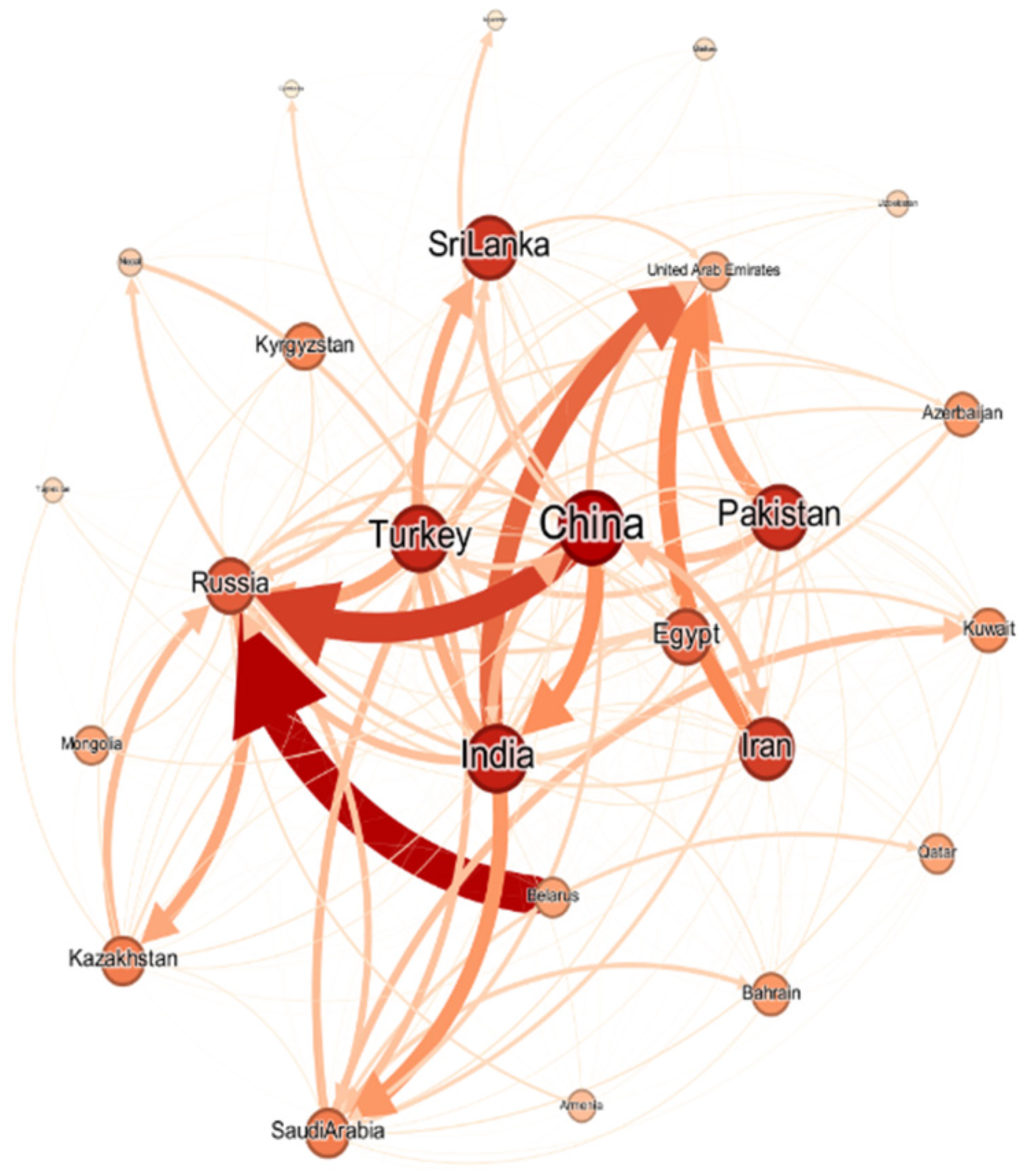
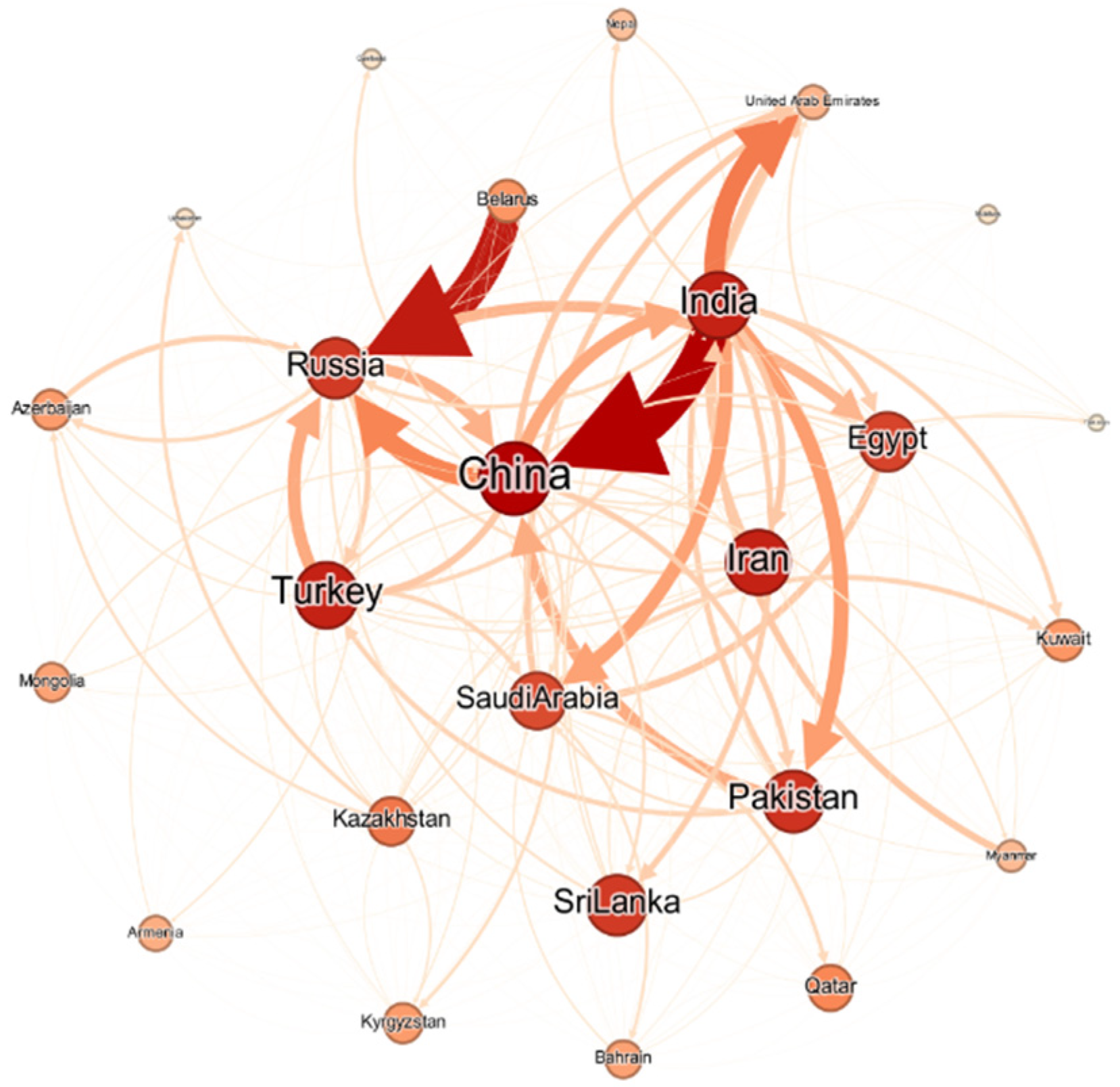


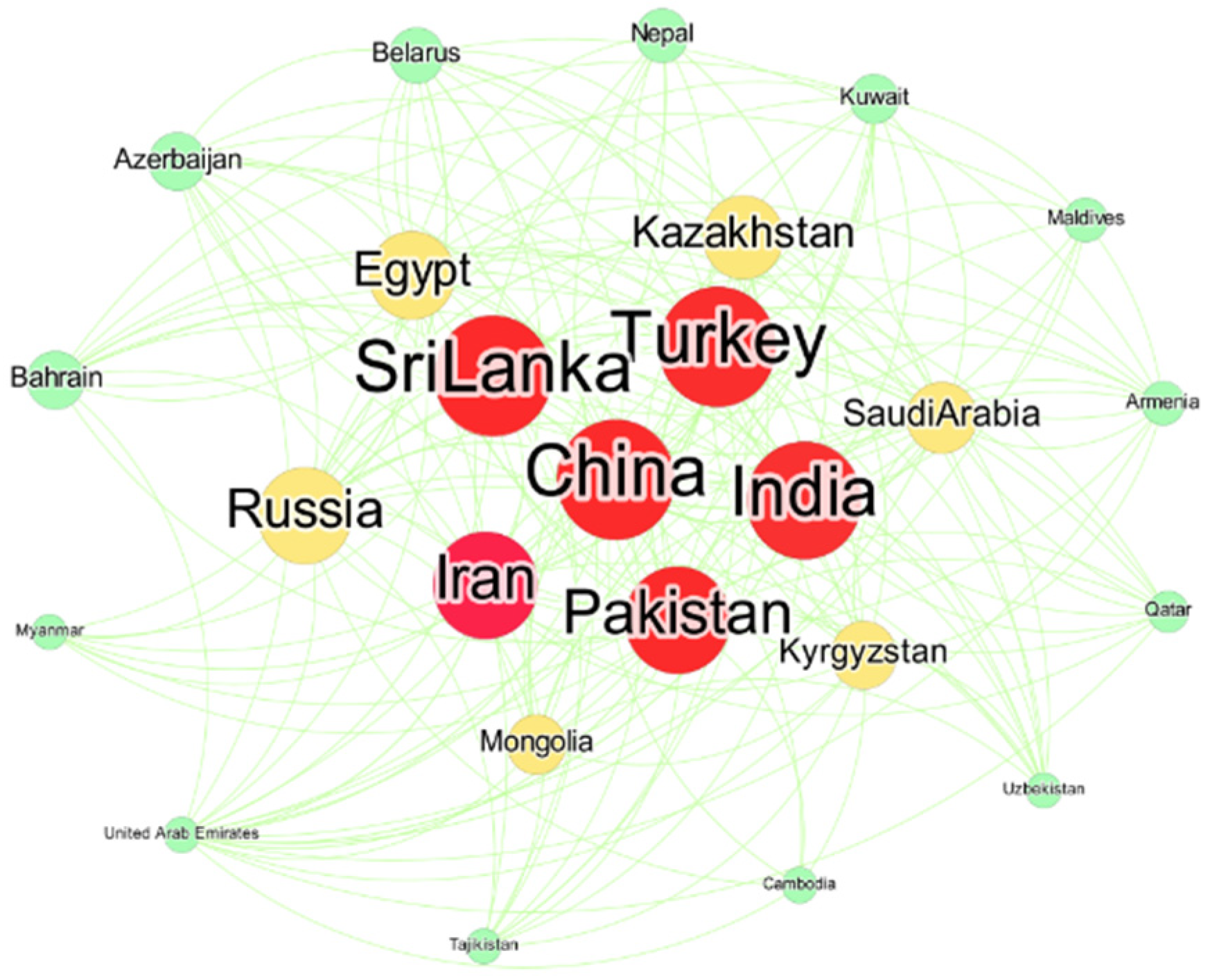
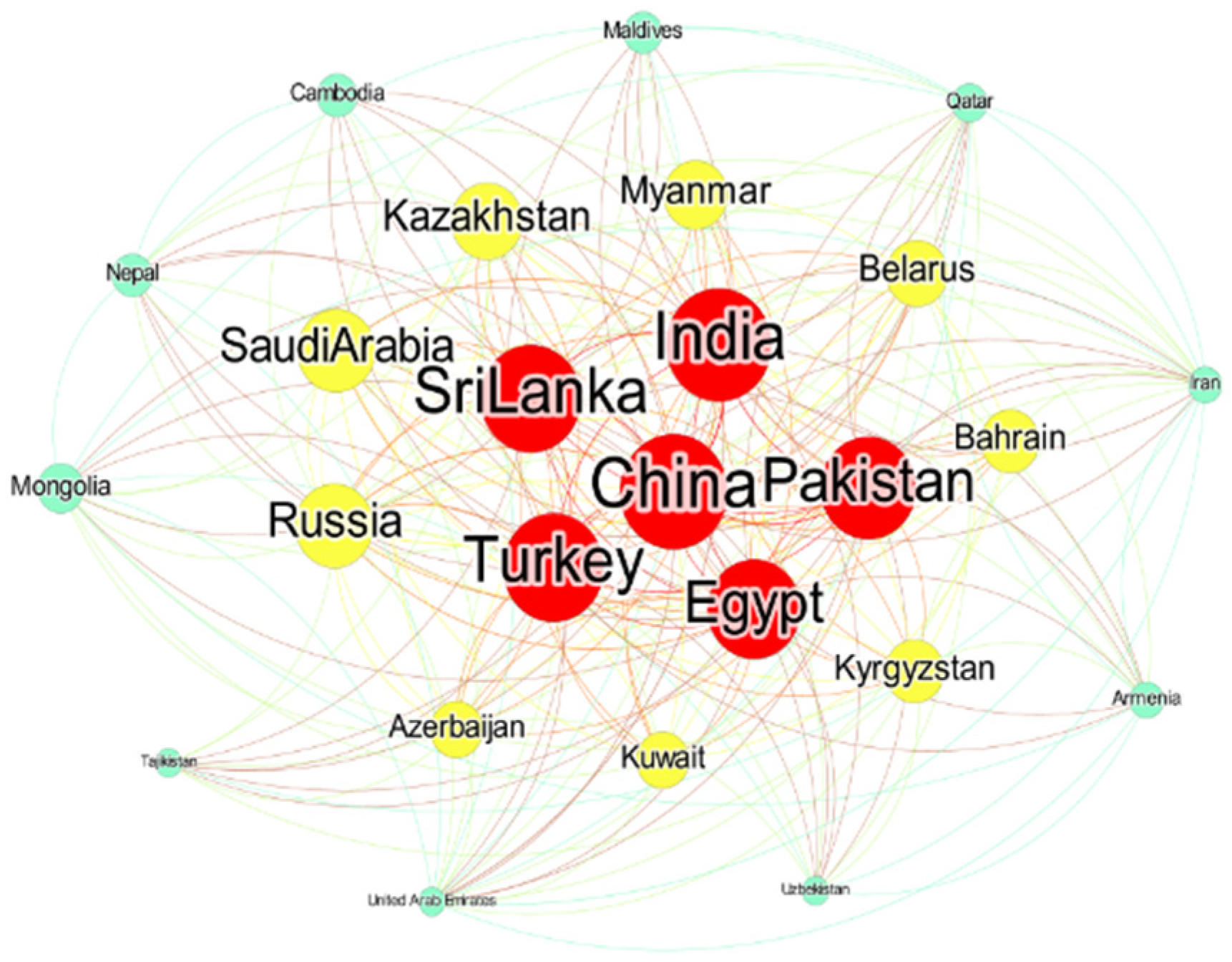
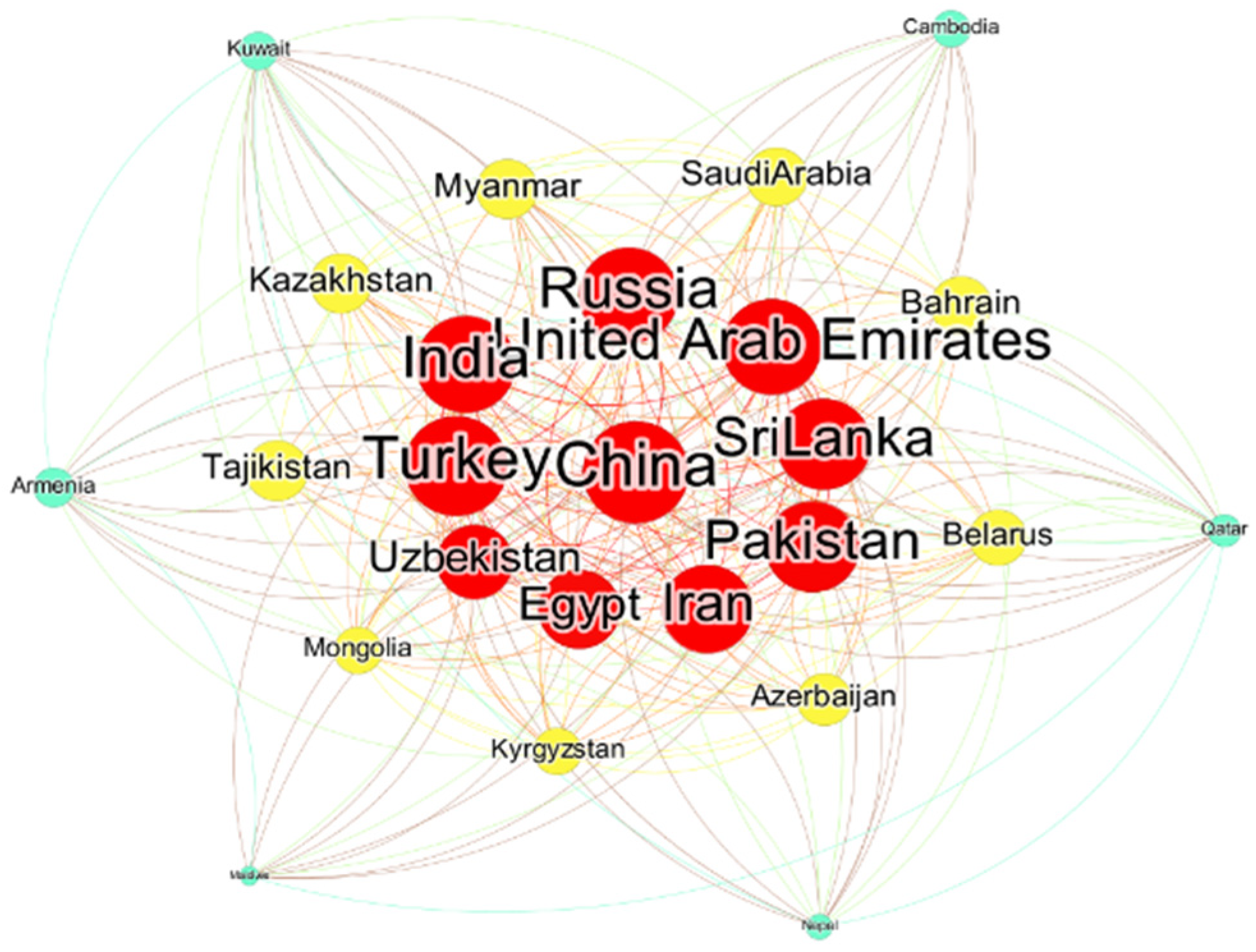


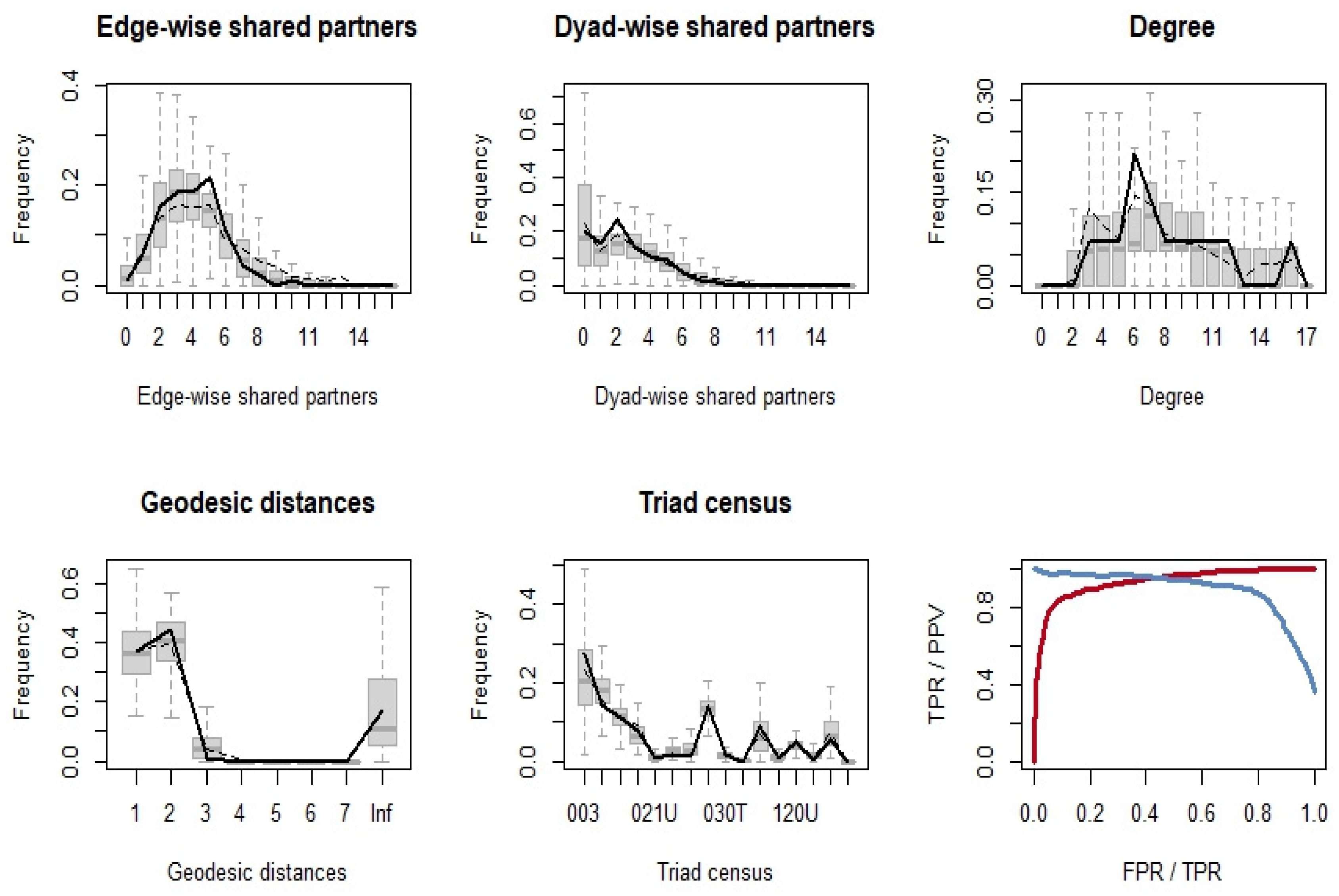
| Category of Member States | Category Country |
|---|---|
| List of member states | China, Kazakhstan, Kyrgyzstan, Russia, Tajikistan, Uzbekistan, India, Pakistan, Iran |
| Observer states | Belarus, Afghanistan, Mongolia |
| Dialogue partners | Sri Lanka, Turkey, Cambodia, Azerbaijan, Nepal, Armenia, Egypt, Qatar, Saudi Arabia, Kuwait, Maldives, Myanmar, UAE, Bahrain |
| Year | 2003 | 2006 | 2009 | 2012 | 2015 | 2018 | 2020 | 2022 |
|---|---|---|---|---|---|---|---|---|
| Network density | 0.315 | 0.3517 | 0.395 | 0.4667 | 0.4867 | 0.4933 | 0.5317 | 0.545 |
| Average clustering coefficient | 0.487 | 0.516 | 0.546 | 0.585 | 0.605 | 0.603 | 0.63 | 0.632 |
| Average path length | 1.715 | 1.616 | 1.575 | 1.498 | 1.5 | 1.465 | 1.472 | 1.439 |
| Reciprocity | 0.4 | 0.4257 | 0.4277 | 0.547 | 0.6222 | 0.6 | 0.5871 | 0.5797 |
| Variable | Meaning | Data | Data Sources |
|---|---|---|---|
| net | Trade relations | Export value of agricultural products | Uncomtrade database |
| edges | Edge | ||
| mutual | Reciprocity | ||
| gwesp | Multiple connectivity | ||
| stability | Stability | ||
| lngdp | Overall economic size | Measured by gross domestic product | World Bank database |
| lnland | Agricultural land | Agricultural land area | |
| lnwater | Tightness of water | The proportion of freshwater withdrawals to available freshwater resources | |
| inf | Chinese influence | China’s agricultural exports as a share of the country’s agricultural GDP | |
| lang | Linguistic proximity matrix | CEPII database | |
| dis | Geographic distance matrix | The direct distance between the two capitals is 1 if the distance is greater than 3000 km; otherwise, it is 0 | |
| bound | Geographic neighbor matrix | The value of the nearest neighbor is 1; otherwise it is 0 |
| Items | Model 1 | Model 2 | Model 3 | Model 4 |
|---|---|---|---|---|
| edges | −28.348 *** | −23.104 *** | −13.803 *** | −9.384 *** |
| (1.320) | (1.280) | (1.233) | (1.581) | |
| mutual | 1.694 *** | 1.336 *** | 1.036 *** | |
| (0.180) | (0.181) | (0.199) | ||
| gwesp | 1.236 *** | 1.004 *** | ||
| (0.105) | (0.104) | |||
| stability | 1.370 *** | |||
| (0.063) | ||||
| edgecov.bound | 0.697 *** | 0.525 ** | 0.872 *** | 0.562 * |
| (0.193) | (0.174) | (0.181) | (0.243) | |
| edgecov.lang | 2.596 *** | 1.999 *** | 2.122 *** | 0.783 * |
| (0.297) | (0.266) | (0.238) | (0.328) | |
| edgecov.dis | −0.741 *** | −0.575 *** | −0.400 *** | −0.252 |
| (0.109) | (0.101) | (0.096) | (0.135) | |
| nodeocov.land | 0.105 *** | 0.127 *** | 0.118 *** | 0.082 ** |
| (0.027) | (0.028) | (0.024) | (0.031) | |
| nodeocov.gdp | 0.710 *** | 0.670 *** | 0.450 *** | 0.297 *** |
| (0.045) | (0.047) | (0.044) | (0.055) | |
| nodeocov.inf | 0.077 *** | 0.077 *** | 0.042 *** | 0.028 * |
| (0.009) | (0.010) | (0.009) | (0.012) | |
| nodeocov.water | −0.041 | −0.043 | −0.084 * | −0.070 |
| (0.037) | (0.039) | (0.033) | (0.043) | |
| nodeicov.land | −0.046 | −0.071 ** | −0.035 | −0.010 |
| (0.025) | (0.026) | (0.023) | (0.033) | |
| nodeicov.gdp | 0.371 *** | 0.172 *** | −0.051 | −0.069 |
| (0.041) | (0.047) | (0.046) | (0.059) | |
| nodeicov.inf | 0.024 * | 0.001 | −0.021 * | −0.020 |
| (0.010) | (0.011) | (0.010) | (0.014) | |
| nodeicov.water | −0.029 | −0.002 | 0.014 | 0.053 |
| (0.037) | (0.038) | (0.035) | (0.049) | |
| Num. obs. | 3060 | 3060 | 3060 | 2754 |
| AIC | 2671.792 | 2572.818 | 2426.032 | 1642.408 |
| BIC | 2744.106 | 2681.763 | 2551.737 | 1773.112 |
| Log Likelihood | −1323.896 | −1273.409 | −1198.016 | −805.204 |
| Items | Model 5 | Model 6 | Model 7 | Model 8 | Model 9 | Model 10 |
|---|---|---|---|---|---|---|
| edges | −30.020 *** | −24.907 *** | −16.421 *** | −13.437 *** | −15.08 * | −19.21 *** |
| (1.412) | (1.363) | (1.411) | (2.096) | (2.54) | ||
| mutual | 1.552 *** | 1.249 *** | 0.923 *** | 1.43 * | 1.69 *** | |
| (0.175) | (0.178) | (0.227) | (0.35) | |||
| gwesp | 0.842 *** | 0.917 *** | ||||
| (0.089) | (0.131) | |||||
| stability | 1.890 *** | 1.48 * | ||||
| (0.078) | ||||||
| edgecov.bound | 0.612 ** | 0.483 ** | 0.681 *** | 0.418 | 0.27 | 0.70 |
| (0.195) | (0.180) | (0.187) | (0.292) | (0.39) | ||
| edgecov.lang | 2.577 *** | 2.046 *** | 1.929 *** | 0.411 | 0.83 | 0.93 |
| (0.286) | (0.254) | (0.217) | (0.371) | (0.49) | ||
| edgecov.dis | −0.877 *** | −0.699 *** | −0.552 *** | −0.294 | −0.29 * | −0.88 *** |
| (0.113) | (0.103) | (0.097) | (0.176) | (0.21) | ||
| nodeocov.land | 0.116 *** | 0.127 *** | 0.102 *** | 0.051 | 0.08 | 0.23 *** |
| (0.028) | (0.029) | (0.025) | (0.039) | (0.06) | ||
| nodeocov.gdp | 0.782 *** | 0.754 *** | 0.540 *** | 0.418 *** | 0.48 * | 0.47 *** |
| (0.047) | (0.049) | (0.047) | (0.069) | (0.09) | ||
| nodeocov.inf | 0.080 *** | 0.081 *** | 0.051 *** | 0.043 ** | 0.05 * | 0.11 *** |
| (0.010) | (0.010) | (0.009) | (0.015) | (0.02) | ||
| nodeocov.water | −0.057 | −0.057 | −0.109 ** | −0.091 | −0.03 | 0.11 |
| (0.039) | (0.041) | (0.034) | (0.054) | (0.07) | ||
| nodeicov.land | −0.018 | −0.038 | −0.024 | −0.003 | −0.03 | −0.09 |
| (0.026) | (0.026) | (0.024) | (0.041) | (0.05) | ||
| nodeicov.gdp | 0.345 *** | 0.146 ** | −0.042 | −0.011 | 0.06 | 0.17 |
| (0.043) | (0.049) | (0.048) | (0.075) | (0.09) | ||
| nodeicov.inf | 0.017 | −0.003 | −0.019 | −0.009 | −0.00 | 0.04 * |
| (0.011) | (0.011) | (0.011) | (0.017) | (0.02) | ||
| nodeicov.water | −0.040 | −0.010 | 0.007 | 0.054 | 0.05 | −0.03 |
| (0.038) | (0.039) | (0.035) | (0.060) | (0.07) | ||
| Num. obs. | 3060 | 3060 | 3060 | 2754 | 2754 | 2754 |
| AIC | 2567.428 | 2490.740 | 2363.904 | 1234.112 | 595.99 | |
| BIC | 2639.742 | 2599.684 | 2489.609 | 1364.816 | 653.15 | |
| Log Likelihood | −1271.714 | −1232.370 | −1166.952 | −601.056 | −284.99 |
Disclaimer/Publisher’s Note: The statements, opinions and data contained in all publications are solely those of the individual author(s) and contributor(s) and not of MDPI and/or the editor(s). MDPI and/or the editor(s) disclaim responsibility for any injury to people or property resulting from any ideas, methods, instructions or products referred to in the content. |
© 2024 by the authors. Licensee MDPI, Basel, Switzerland. This article is an open access article distributed under the terms and conditions of the Creative Commons Attribution (CC BY) license (https://creativecommons.org/licenses/by/4.0/).
Share and Cite
Abudukeremu, A.; Youliwasi, A.; Abula, B.; Yiming, A.; Wang, D. Study on the Evolution of SCO Agricultural Trade Network Pattern and Its Influencing Mechanism. Sustainability 2024, 16, 7930. https://doi.org/10.3390/su16187930
Abudukeremu A, Youliwasi A, Abula B, Yiming A, Wang D. Study on the Evolution of SCO Agricultural Trade Network Pattern and Its Influencing Mechanism. Sustainability. 2024; 16(18):7930. https://doi.org/10.3390/su16187930
Chicago/Turabian StyleAbudukeremu, Abudureyimu, Asiyemu Youliwasi, Buwajian Abula, Abulaiti Yiming, and Dezhen Wang. 2024. "Study on the Evolution of SCO Agricultural Trade Network Pattern and Its Influencing Mechanism" Sustainability 16, no. 18: 7930. https://doi.org/10.3390/su16187930






